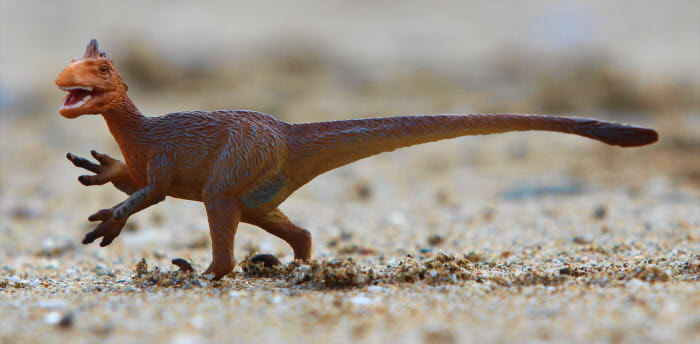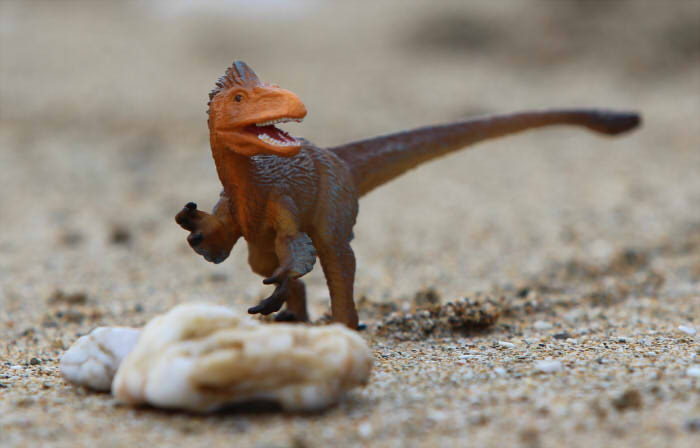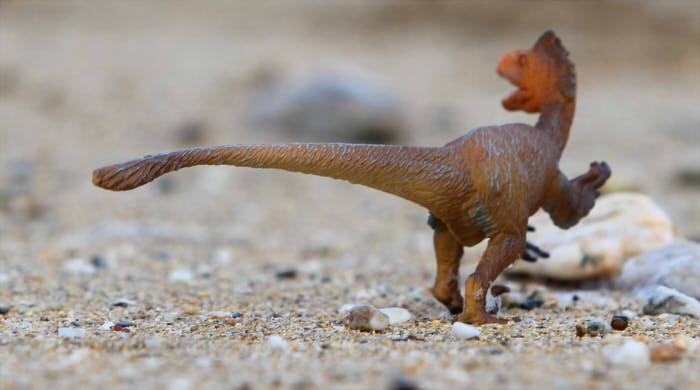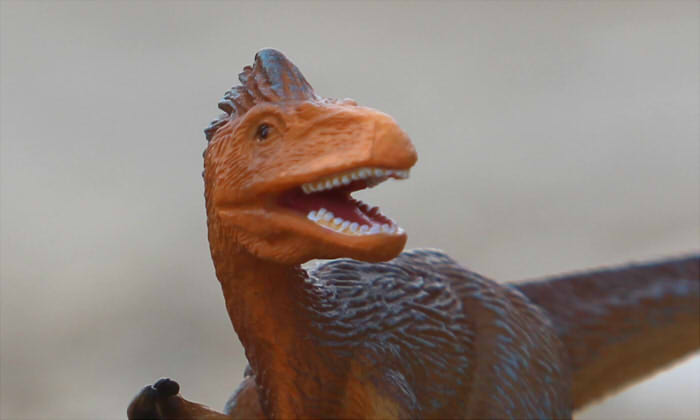Review and photographs by Tallin, edited by Plesiosauria.
As one of the largest of the dromaeosaurids, Utahraptor ostrommaysorum perhaps first garnered significant public attention after starring in the 1999 animated documentary, Walking with Dinosaurs. Since this time, the scientifically accepted appearance of this 7m theropod has changed considerably, as more evidence has been unearthed supporting the idea that this creature was fully feathered – much like its far smaller kin. This predator has appeared in toy/model form several times, from the original WWD merchandise to the most recent rendition from Rebor [not yet reviewed on the dinotoyblog – any takers? – Ed.]. The subject of this review however, is the little 2011 Utahraptor from CollectA – a seemingly overlooked figure in my opinion.

The very first Utahraptor specimens were unearthed in 1975, and were rather fragmentary. It was not until 1991, where a huge foot-claw was discovered along with some other remains, that the genus was more thoroughly examined and named in 1993. Comparable to a polar bear in size, this animal would have been one of the top predators of its day, living along side other North American dinosaurs such as Gastonia and Cedarosaurus.

At about 13cm from the tip of the snout to the end of the tail, this model is rather diminutive at about 1:50 scale. It does, however, contain a lot of detail considering its size. Interestingly, the whole body (yes, even the head) is covered with a downy feather texture – no half-naked raptors here! The feathers form longer tufts at the top of the head, the end of the tail and the back of the thighs as well as the arms. The arm feathers look almost as if to resemble more developed flight feathers, however it is hard to be sure when these details are so tiny. The claws are all well defined, as is muscle tone and the details on the head. The mouth is filled with individual little teeth and a simple tongue. This model is all over a warm caramel colour, with darker tones along the top and at the end of the limbs. The head is a bright tangerine orange with bright white teeth and a pink mouth. The eyes are soulless black pin-pricks and the body appears to have been airbrushed with a pale grey. The model is posed in an alert walking stance, with the head turned attentively to the left.

In terms of the hits and misses of this toy, I would happily conclude that there are far more hits. Firstly, the figure stands on its own two feet, neither of which seem to have been swollen up too much to help the figure stand. True, my model falls over a lot, but I think that is more to do with the legs seeming a little bent or warped due to storage or shipping. The tail is held proudly and stiffly behind the animal, as it should have been since dromaeosaurs had stiffened tails to help with balance and agility. The hands are also very pleasingly not pronated at all. For such a small and attractively priced model, the proportions seem to more or less be all in order. The fingers could perhaps be longer and the thumb claw larger, but these are very nit-picky comments. My main issue is with the head – it seems very wide and rather too short compared to reconstructions and fossil specimens. The neck also seems a little short. CollectA, whilst adorning the raptor with liberal amounts of downy feathers, have been rather conservative on the arms. Many palaeontologists now believe that the feather coverage of larger dromaeosaurids would have resembled that of their smaller relatives – so even huge animals like the Utahraptor could have had advanced primary feathers on the arms. Then again, there is still no solid fossil evidence for feathers on Utahraptor, so I won’t count it as a strike against this model.

All in all, I think that this model is a very good offering from CollectA. They have crammed a huge amount of detail into a very small model, and the fact that it seems mostly accurate is also very commendable. Raptors are always popular with children so this model should go down will with a younger owner, and with a fairly interesting pose and an open mouth has plenty of playability. That said, I can imagine that this model might snap if subjected to too much stress, as it is made more a harder, less flexible plastic than many of CollectA’s dinosaurs to help it stand. In any case, this is a very small but very detailed and sprightly replica of Utahraptor, and I would advise any theropod lover to add one to their collection – especially as it can be found easily at a very tempting price at under £4 – that is, if you don’t mind the rather beefed up head.
Available from Amazon.com here (for some reason the price for this figure is astronomical at the moment – a mistake, surely) and Ebay.com here (much cheaper, but the cheapest one is misspelled ‘Utahtaptor’, so search for that if you can’t find what you are looking for!).
Disclaimer: links to Ebay and Amazon on the DinoToyBlog are affiliate links, so we make a small commission if you use them. Thanks for supporting us!




This figure also complements CollectA’s 2014 Gastonia quite nicely.
This miniature utahraptor of collecta difference is better than other more elaborate figures of other factories they have been referred.
It shows that a being of affordable figure, more than modest size and a more humble material is much better by far than other figures made and to which reference has been made in the article, indeed magnificent.